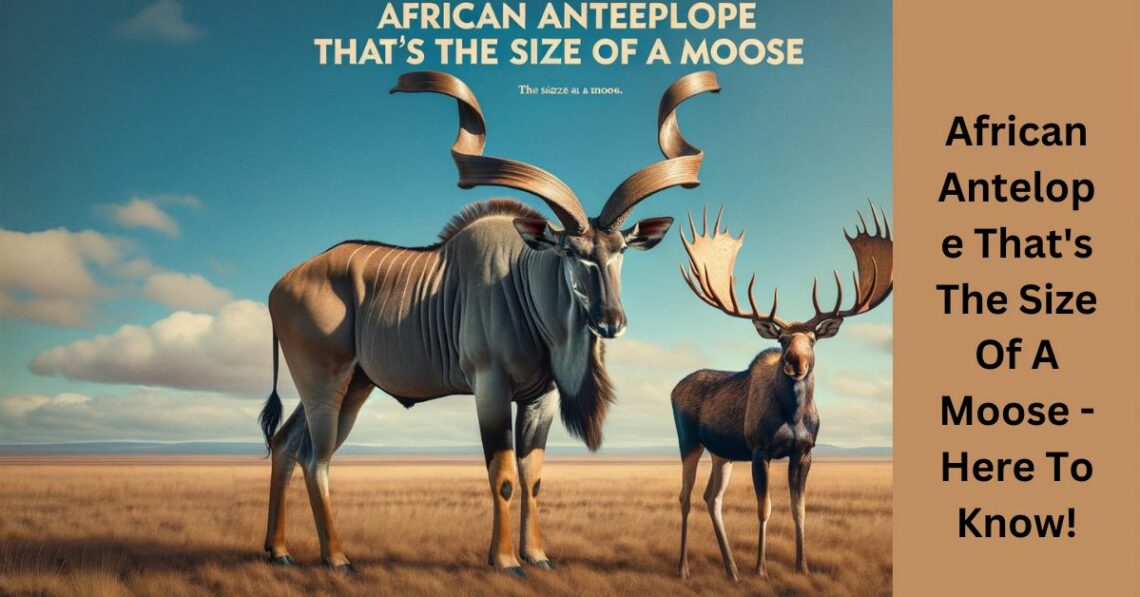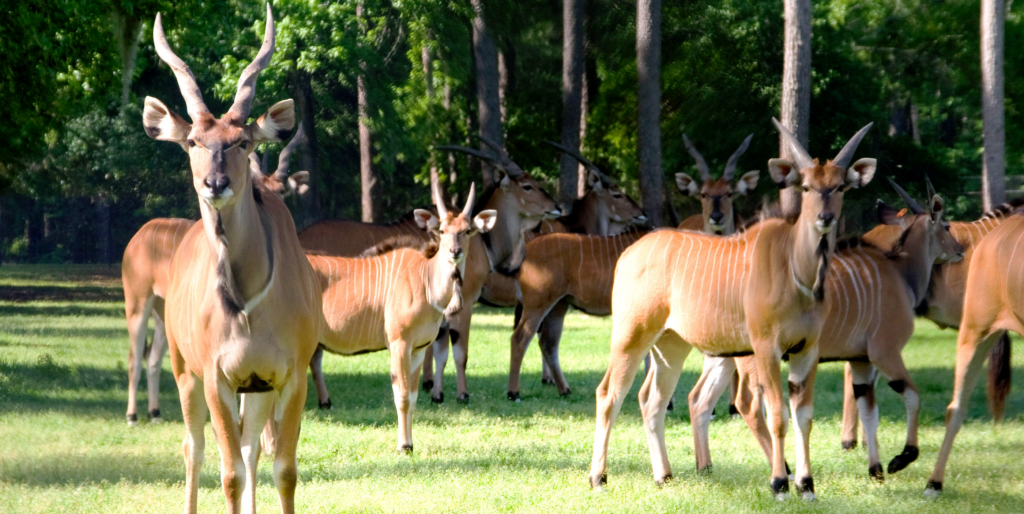
African Antelope That’s The Size Of A Moose – Here To Know!
Africa, renowned for its diverse wildlife, is home to some of the most fascinating creatures on the planet. Among them, there exists an extraordinary antelope species that captures the imagination – a species comparable in size to the iconic moose.
This majestic creature, known for its imposing stature and graceful demeanor, adds another layer of wonder to Africa’s rich biodiversity.
Table of Contents
ToggleThe Giant Eland (Taurotragus derbianus) – Here To Know!
The African antelope that rivals the moose in size is none other than the Giant Eland (Taurotragus derbianus).

Also referred to as the Lord Derby Eland, this colossal herbivore belongs to the Bovidae family and is found in various regions across central and West Africa.
Named after Edward Smith-Stanley, the 13th Earl of Derby, the Giant Eland stands as one of the largest antelope species globally and holds a special place in the hearts of wildlife enthusiasts and conservationists.
Physical Characteristics – Explore Now!
1. Size and Build:
The Giant Eland boasts an impressive size, with males weighing up to 2,000 pounds (900 kg) and standing at a shoulder height of about 6 feet (1.8 meters).
This places it in the same weight class as the moose, making it one of the heaviest antelopes in the world. The females are generally smaller, but they still exhibit a formidable presence in comparison to other antelope species.
Also Read: IS ARK CROSS PLATFORM – LET’S UNCOVER THE TRUTH IN 2024!
2. Distinctive Features:
One of the most distinctive features of the Giant Eland is its large, spiral-shaped horns. Males typically have longer and more robust horns that can reach up to 4 feet (1.2 meters) in length.
The twisted, corkscrew appearance of their horns adds to the imposing allure of these magnificent creatures. The Giant Eland’s coat is tan to reddish-brown, and they have vertical white stripes on their sides, enhancing their regal appearance.
3. Habitat and Range:
The Giant Eland prefers a variety of habitats, including woodlands, savannas, and grasslands. Its range extends across countries such as Senegal, Mali, Guinea, Sierra Leone, Ivory Coast, and Nigeria.
These antelopes are well-adapted to different environments, displaying their versatility in thriving amidst diverse landscapes.
Behavior and Social Structure – Go In-Depth!
1. Social Groups:
Giant Elands are social animals, forming herds that typically consist of females, their offspring, and occasionally, a dominant male.

The males are known for their impressive displays during the breeding season, where they engage in elaborate rituals to establish dominance and attract females. These displays involve head-butting and locking horns, showcasing the strength and power of these magnificent creatures.
2. Communication:
Communication within Giant Eland herds involves a combination of vocalizations, body language, and scent marking.
The deep, resonant barks and grunts of the males are distinctive and can carry over long distances, serving as a means of maintaining contact within the herd and deterring potential threats.
Also Read: WHAT MIGHT BE FOUND OUTSIDE A HIPSTER – HERE TO KNOW!
3. Diet and Feeding Habits:
Giant Elands are herbivores with a diverse diet, primarily consisting of grasses, leaves, and fruits. Their adaptability allows them to thrive in regions with seasonal changes in vegetation, ensuring a consistent food supply throughout the year.
The ability to consume a wide variety of plant material contributes to their success in various ecosystems.
4. Conservation Status:
Despite their grandeur, the Giant Eland faces several challenges that threaten its survival in the wild. Habitat loss, poaching, and competition with domestic livestock pose significant threats to their populations.
Conservation efforts are underway in several African countries to protect and preserve the habitats of these majestic antelopes. Initiatives include establishing protected areas, implementing anti-poaching measures, and promoting community-based conservation projects.
Economic and Ecological Importance – Gain Your Knowledge!
1. Tourism and Conservation:
The charismatic appeal of the Giant Eland makes it a flagship species for ecotourism initiatives. Observing these majestic antelopes in their natural habitat attracts wildlife enthusiasts, generating revenue for local communities and contributing to conservation efforts.

Sustainable tourism practices play a crucial role in fostering a balance between economic development and wildlife preservation.
2. Ecosystem Role:
As herbivores, Giant Elands play a vital role in shaping the ecosystems they inhabit. Their feeding habits contribute to controlling vegetation, influencing plant growth and distribution.
Additionally, their presence can impact the behavior of other species, creating a complex web of ecological interactions within their respective habitats.
Also Read: IS ARK CROSS PLATFORM – LET’S UNCOVER THE TRUTH IN 2024!
Conclusion:
At the end of the article,
This extraordinary creature, celebrated for its commanding presence and elegant demeanor, contributes an additional dimension of awe to the diverse tapestry of Africa’s flourishing biodiversity.
FAQ’s:
Q1: What sets the Giant Eland apart from other antelope species?
The Giant Eland distinguishes itself with its impressive size, comparable to the iconic moose, making it one of Africa’s largest herbivores.
Q2: Where is the primary habitat of the Giant Eland?
The Giant Eland thrives in diverse landscapes, ranging from woodlands and savannas to grasslands, across central and West Africa.
Q3: How do Giant Elands communicate within their herds?
Giant Elands utilize a combination of deep barks and grunts, serving as distinctive vocalizations to maintain herd contact and deter potential threats.
Q4: What role do Giant Elands play in their ecosystems?
As herbivores, Giant Elands significantly influence ecosystems by shaping vegetation through their feeding habits, creating a ripple effect on plant growth and distribution.
Q5: What conservation challenges do Giant Elands face in the wild?
Giant Elands confront threats such as habitat loss, poaching, and competition with domestic livestock, necessitating conservation efforts to safeguard their populations.
Q6: How does ecotourism contribute to the conservation of Giant Elands?
Ecotourism initiatives centered around the Giant Eland not only attract wildlife enthusiasts but also generate revenue for local communities, fostering a balance between economic development and conservation.
You May Also Like

Oswego Brightspace – The Ultimate Guide!
February 28, 2024
Invisalign Doctor Site – The Ultimate Guide For You!
March 4, 2024